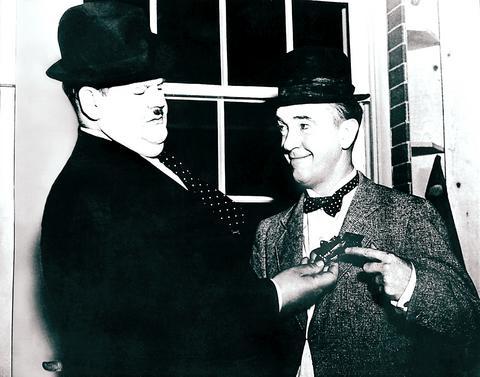Film historians have found a rare Laurel and Hardy short that the famed comedy duo filmed for German audiences -- speaking their lines in phonetic German, according to the Munich Film Museum.
The 1931 short is being hailed as one of the rare examples of the fad in early talkies of having stars speak their own lines in another language for foreign audiences.

PHOTO: DPA
In this case, Stan and Ollie could not speak a word of German themselves and made a hash of reciting the German dialogue from cue cards, a museum spokesman said.
"You can't understand a word they're saying," said Klaus Volkmer, a spokesman for the Munich Film Museum, which unearthed the film in a Moscow cinema archive.
"That fact, of course, makes the film even funnier," he said.
The short was produced in Hollywood in 1931 -- the early days of the talkies -- when it was common practice for films to be cranked out in various language versions for foreign markets.
When Edward Robinson played Little Caesar, the studio forced him to repeat his performance speaking the same lines in Spanish, French and German for overseas audiences.
When actors baulked at speaking lines in a foreign language -- or their accents were execrable -- native-speakers were brought in to play the parts. Charles Boyer, already a big star in France, got his start in Hollywood by speaking French dialogue for stars whose American accents would have repulsed French audiences.
In the case of Laurel and Hardy in Ghost At Midnight, the two comics opted to speak the roles themselves for the German-language
production, entitled Spuk Um Mitternacht.
"They apparently figured they had nothing to lose by giving it a try," Volkmer said. "And at any rate, you couldn't replace them with two other actors. German audiences loved Laurel and Hardy and wouldn't have settled for anybody else in their roles."
The short debuted in Berlin on May 21, 1931, billed as "Laurel and Hardy's First All-German Talkie." In fact, there is very little actual dialogue in the film, as was often the case in very early talkies.
A few lines of German dialogue were thrown in between silent scenes, from two previous Stan and Ollie shorts, Berthmarks and The Laurel-Hardy Murder Case. The restored, 40-minute film was screened in Berlin two weeks ago prior to a retrospective showing at the Munich Film Museum on Oct. 26 and Oct. 27.

May 11 to May 18 The original Taichung Railway Station was long thought to have been completely razed. Opening on May 15, 1905, the one-story wooden structure soon outgrew its purpose and was replaced in 1917 by a grandiose, Western-style station. During construction on the third-generation station in 2017, workers discovered the service pit for the original station’s locomotive depot. A year later, a small wooden building on site was determined by historians to be the first stationmaster’s office, built around 1908. With these findings, the Taichung Railway Station Cultural Park now boasts that it has

Wooden houses wedged between concrete, crumbling brick facades with roofs gaping to the sky, and tiled art deco buildings down narrow alleyways: Taichung Central District’s (中區) aging architecture reveals both the allure and reality of the old downtown. From Indigenous settlement to capital under Qing Dynasty rule through to Japanese colonization, Taichung’s Central District holds a long and layered history. The bygone beauty of its streets once earned it the nickname “Little Kyoto.” Since the late eighties, however, the shifting of economic and government centers westward signaled a gradual decline in the area’s evolving fortunes. With the regeneration of the once

In February of this year the Taipei Times reported on the visit of Lienchiang County Commissioner Wang Chung-ming (王忠銘) of the Chinese Nationalist Party (KMT) and a delegation to a lantern festival in Fuzhou’s Mawei District in Fujian Province. “Today, Mawei and Matsu jointly marked the lantern festival,” Wang was quoted as saying, adding that both sides “being of one people,” is a cause for joy. Wang was passing around a common claim of officials of the People’s Republic of China (PRC) and the PRC’s allies and supporters in Taiwan — KMT and the Taiwan People’s Party — and elsewhere: Taiwan and

Even by the standards of Ukraine’s International Legion, which comprises volunteers from over 55 countries, Han has an unusual backstory. Born in Taichung, he grew up in Costa Rica — then one of Taiwan’s diplomatic allies — where a relative worked for the embassy. After attending an American international high school in San Jose, Costa Rica’s capital, Han — who prefers to use only his given name for OPSEC (operations security) reasons — moved to the US in his teens. He attended Penn State University before returning to Taiwan to work in the semiconductor industry in Kaohsiung, where he